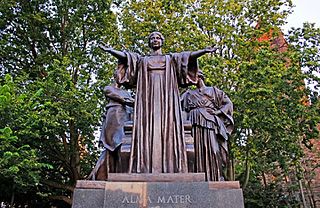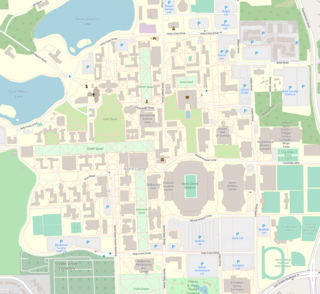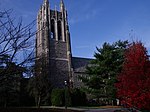
Ball State University is a public research university in Muncie, Indiana. It has two satellite facilities in Fishers and Indianapolis.

Saint Joseph's University is a private Jesuit university in Philadelphia and Lower Merion, Pennsylvania. The university was founded by the Society of Jesus in 1851 as Saint Joseph's College. Saint Joseph's is the seventh oldest Jesuit university in the United States, one of 27 member institutions of the Association of Jesuit Colleges and Universities, and the fourth largest university in Philadelphia. It is named after the earthly father of Jesus, Saint Joseph. On June 1, 2022, Saint Joseph's University acquired University of the Sciences, adding professional programs in health and science, including occupational therapy, physical therapy, pharmacy and physician assistant.

Trinity College is a private liberal arts college in Hartford, Connecticut. Founded as Washington College in 1823, it is the second-oldest college in the state of Connecticut.

Tennessee Technological University, commonly referred to as Tennessee Tech, is a public research university in Cookeville, Tennessee, United States. It was formerly known as Tennessee Polytechnic Institute, and before that as University of Dixie, the name under which it was founded as a private institution. Affiliated with the Tennessee Board of Regents, the university is governed by a board of trustees. It is classified among "R2: Doctoral Universities – High research activity".

Pratt Institute is a private university with its main campus in Brooklyn, New York. It has a satellite campus in Manhattan and an extension campus in Utica, New York at the Munson-Williams-Proctor Arts Institute. The school was founded in 1887 with programs primarily in engineering, architecture, and fine arts. Comprising six schools, the institute is primarily known for its programs in architecture, interior design, and industrial design.

Missouri Southern State University is a public university in Joplin, Missouri. It was established in 1937 as Joplin Junior College. The university enrolled 4,346 students in Fall 2021.

Illinois College is a private liberal arts college in Jacksonville, Illinois. It is affiliated with the United Church of Christ and the Presbyterian Church (USA). It was the second college founded in Illinois, but the first to grant a degree. It was founded in 1829 by the Yale Band, students from Yale College who traveled westward to found new colleges. It briefly served as the state's first medical school, from 1843 to 1848.

Amos Jerome Snell Hall and Charles Hitchcock Hall, more commonly known as Snell–Hitchcock, make up a residence hall at the University of Chicago. The dorm is on the northwest corner of the University's main quadrangles at the corner of 57th St. and Ellis Avenue. It is connected via emergency exits to Searle Chemistry Laboratory. Built in 1892 (Snell) and 1901 (Hitchcock), they are the oldest residence halls still in use as such on the university's campus. Snell is built in a Collegiate Gothic style, while Hitchcock is Prairie Style-inspired Gothic. The buildings feature fireplaces and exteriors of limestone, as well as hardwood molding and trim.
The main campus of Virginia Tech is located in Blacksburg, Virginia; the central campus is roughly bordered by Prices Fork Road to the northwest, Plantation Road to the west, Main Street to the east, and U.S. Route 460 bypass to the south, although it also has several thousand acres beyond the central campus. The Virginia Tech campus consists of 130 buildings on approximately 2,600 acres (11 km2). It was the site of the Draper's Meadow massacre in 1755 during the French and Indian War.

The University of Illinois Urbana-Champaign is an academic research institution located in Urbana, Illinois and the flagship campus of the University of Illinois System. Since its founding in 1867, it has resided and expanded between the twin cities of Champaign and Urbana.

College Hall is the original academic building on La Salle University's campus. It is located at 1900 W. Olney Avenue in Philadelphia, Pennsylvania. College Hall presently houses the Schools of Business and Business Administration, the Campus Ministry Center and the La Salle University Archives. Attached to the Christian Brother's Residence, it is on La Salle's main quadrangle.

Grey Towers Castle is a building on the campus of Arcadia University in Glenside, Pennsylvania which is in Cheltenham Township, a suburb of Philadelphia, United States. The castle was designed by Horace Trumbauer and built starting in 1893 as the estate of William Welsh Harrison. The university purchased the estate in 1929 for $712,500, equal to $11,243,968 today. Classes were split between the two locations until 1962, when the school moved all of its operations to the Glenside area. The castle was designated a National Historic Landmark in 1985 for its architecture.

Howard Hall is one of the 32 Residence Halls on the campus of the University of Notre Dame and one of the 14 female dorms. It is located north of South Dining Hall on University of Notre Dame's South Quad, and is immediately surrounded by Badin Hall on the east, Morrissey Manor on the west, and Bond Hall on the north. Built in 1924–1925, it is dedicated to Timothy Edward Howard, and hosts 145 undergraduates. The coat of arms is based on that of the Howard family adapted to fit Howard Hall, changed to match those of the hall, and the lions were substituted with ducks.

David R. Francis Quadrangle is the historical center of the University of Missouri in Columbia, Missouri. Known as The Quad it is the oldest part of Red Campus and adjacent to Downtown Columbia at the south end of the Avenue of the Columns. At its center are six Ionic columns, all that remains of the original university building Academic Hall. Twelve buildings front the modern quadrangle including the domed main administration building Jesse Hall, the tallest building in Columbia. The Quad was designed and constructed by architect Morris Frederick Bell and his assistant William Lincoln Garver. It is named after Missouri governor David R. Francis. Eighteen structures, including the entire quad and most of Red Campus are listed as the Francis Quadrangle National Historic District. An obelisk, the original tombstone of Thomas Jefferson stands in front of the Chancellor's Residence. It was gifted to the University by Jefferson's descendants in recognition of Missouri's ties to Virginia. In front of Jesse Hall stand markers honoring university president Richard Henry Jesse and Missouri governor David R. Francis. Nearby is another obelisk in memory of Missouri's first U.S. senator David Barton, The Missouri School of Journalism is located at the northeast corner of The Quad, comprising Walter Williams Hall, Neff Hall, Gannet Hall, along with the Reynolds Journalism Institute. To the west, Switzler Hall is the oldest academic building on campus, though the Residence on the Quad, home of the chancellor, is the oldest building overall. The University of Missouri College of Engineering completes the west side. Pickard Hall is currently closed due to radiation contamination from turn of the century experiments. Swallow Hall was recently renovated and houses the Departments of Anthropology, Visual Studies and Ancient Mediterranean Studies.
The Campus of the University of Southern California, also known as the University Park Campus is located in the Exposition Park neighborhood of Los Angeles, California. The campus sprawls across 226 acres and contains most of the academic facilities and residential buildings of the University of Southern California. The University Park campus is in the University Park district of Los Angeles, 2 miles (3.2 km) southwest of downtown Los Angeles. The campus's boundaries are Jefferson Boulevard on the north and northeast, Figueroa Street on the southeast, Exposition Boulevard on the south, and Vermont Avenue on the west. Since the 1960s, through-campus vehicle traffic has been either severely restricted or entirely prohibited on some thoroughfares. The University Park campus is within walking distance to Los Angeles landmarks such as the Shrine Auditorium and Los Angeles Memorial Coliseum, which is operated and managed by the University. Most buildings are in the Romanesque Revival style, although some dormitories, engineering buildings, and physical sciences labs are of various Modernist styles that sharply contrast with the predominantly red-brick campus. Widney Alumni House, built-in 1880, is the oldest university building in Southern California. In recent years the campus has been renovated to remove the vestiges of old roads and replace them with traditional university quads and gardens. The historic portion of the main campus was listed on the National Register of Historic Places in 2015.

Central Campus is the primary academic and administrative section of Cornell University's Ithaca, New York campus. It is bounded by Libe Slope on the west, Fall Creek on the north, and Cascadilla Creek on the South.

The campus of the University of Notre Dame is located in Notre Dame, Indiana, and spans 1,250 acres comprising around 170 buildings. The campus is consistently ranked and admired as one of the most beautiful university campuses in the United States and around the world, particularly noted for the Golden Dome, the Basilica and its stained glass windows, the quads and the greenery, the Grotto, Touchdown Jesus, its collegiate gothic architecture, and its statues and museums. Notre Dame is a major tourist attraction in northern Indiana; in the 2015–2016 academic year, more than 1.8 million visitors, almost half of whom were from outside of St. Joseph County, visited the campus.

The Quadrangle Dormitories are a complex of 39 conjoined residence houses at the University of Pennsylvania, in Philadelphia, Pennsylvania, United States. The architectural firm of Cope and Stewardson designed the houses in an exuberant Neo-Jacobean version of the Collegiate Gothic style, and completed most of them between 1894 and 1912. The dormitories stretch from 36th to 38th Streets and from Spruce Street to Hamilton Walk. West of the Memorial Tower at 37th Street, the houses on the north side follow the diagonal of Woodland Avenue and form a long triangle with the houses on the south side. From 1895 to 1971, the dormitories housed only male students.

















